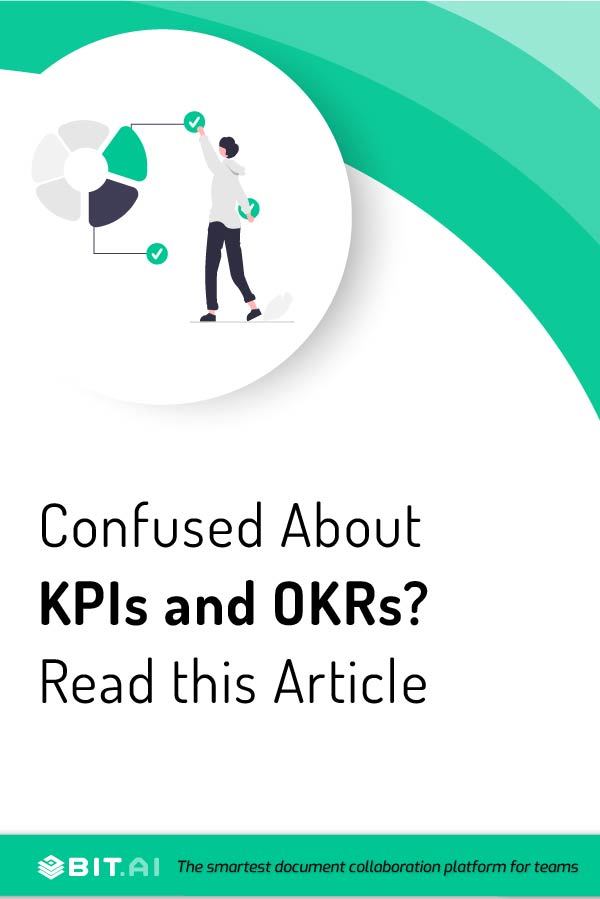If you wish to understand the current state of your business and what’s working and what’s not, then you need to track and measure your business performance with performance metrics.
Two very popular performance frameworks are OKRs and KPIs. And they are not just another business acronym that you come across, they are known for providing businesses with visibility, productivity, and profitability.
This might get you wondering – what exactly are OKR and KPI? Worry not, that’s where we come in to help.
By the time you’re done reading this blog, you’ll be equipped with all you need to know about both OKRs and KPIs. So let’s get started!
What Is an OKR? (Defintion)
OKR stands for Objectives and Key Results. In its most basic sense, OKR is a method that is used to define as well as manage goals usually for a set period of time. This time period in most cases is quarterly.
OKRs are made up of a multitude of objectives and propositions, all properly defined in order to attain set goals. Whether such propositions and objectives are achieved is managed using ‘Key Results’. They benchmark and monitor how we get to the objective. An important note to remember is that these ‘Key Results’ must be specific, time-bound, realistic, and measurable.
In a way, OKRs are therefore a form of outcome management because the goals it contains are not defined based on the work and effort invested in them, but rather by the effect it has on a customer i.e., whether it added value for a customer.
The thing about OKRs is that they are flexible and adaptable. It can be used at all levels of an organization. For instance, OKRs can be defined for the entirety of the company, at a departmental level, or can even be utilized by employees to set individual goals. OKRs are by nature, a strategic framework and are quantifiable, time-lined, and ambitious.
What Are The Different Types Of OKRs?
OKRs can be divided into two main types – Committed OKRs and Aspirational OKRs. Both have properly defined purposes as well as methods to achieve them. We’ll explain further:
1. Committed OKRs
Committed OKRs are goals that need to be achieved within a time period. In order to attain success using this OKR, priority must be given to everyone on board. A committed OKR is therefore ambitious by nature as it pushes a team to strive towards an ‘ambitious’ yet realistic goal. The goals set out are within reach enabling the team to focus on certain specific priorities, thereby leaving less room for failure.
2. Aspirational OKRs
Aspirational OKRs on the other hand are goals that are ‘audacious’ in nature. They are quite nuanced because they set the bar of success way higher in hopes that a team will be inclined to hustle harder to achieve it.
This type of OKR has seen a lesser rate of achievement as the bar is set so high, but the entire process is perceived to be worth the struggle because it pushes everyone involved to think bigger, dream larger, and put in more effort.

Examples of OKRs
Examples of OKRs are many because OKRs can be utilized at all levels of an organization. Here are some examples:
- OKR for a CEO: The objective could be to grow business and key results can be launching a new product or increasing revenue by x dollar amount.
- OKR for Marketing Goals: The objective can be to optimize customer acquisition and the key result can be an improved marketing automation process.
- OKR for Top Company Objective: The bbjective could be to create a great company culture for employees and key results can be developing an efficient feedback process and providing rewards and incentives.
What Is a KPI? (Definition)
KPI is an acronym and its full form is Key Performance Indicator. They are, as their name suggests, performance indicators or metrics that determine as well as evaluate the success of an organization or even just an activity or initiative. KPIs can be used for projects, for programs, and they can apply to products and even different kinds of initiatives and activities. This basically means that they can be used to measure the success of a plethora of things – from generic sales goals to social media metrics.
They are efficient because they set out measurable goals and provide numbers to show for them. These numbers can showcase just how effectively a project or a goal is progressing toward success.
It is mostly utilized in business as it can be used as a tool to set numerical targets in order to achieve specific goals. Usually, KPIs are used by companies to demonstrate revenue targets and reflect the monthly growth of various business metrics.
It must be noted that the value of any KPI is proved only by the results it can show. Many companies or organizations often try to copy-paste others’ success by adapting the same KPI used by them. But this does not lead to success. A KPI must suit your goals and be tailored to your needs and circumstances in order for it to work for you.
What Are The Different Types Of KPIs?
Key Performance Indicators are of various kinds. Different types exist but the most prominent ones will be briefly mentioned:
1. Quantitative KPI
Measured solely by numbers and are of two types – Continuous (that can take any value) and Discrete (are whole numbers). Quantitative KPIs are the most straightforward KPIs.
2. Qualitative KPI
Characteristic of a process or business decision and not measured by numbers. This indicator focuses more on experiences and feelings and the best example of a qualitative indicator would be employee satisfaction surveys.
3. Leading KPI
Leading KPIs are used as indicators to confirm long-term trends in data or predict the outcome of a change in a process. Thus, leading KPIs enable predictive decision-making by studying what might happen.
4. Lagging KPI
These indicators are used to assess results after an initiative or action has been undertaken to measure whether it was a success. Lagging KPIs review performance history and also analyze the impact of a business decision.
5. Input KPI
Input KPIs are the indicators used to measure the required amounts or resources for a project or initiative. They are also used to track resource efficiency and this is especially important in the case of large-scale projects.
6. Process KPI
This type of KPI is used to scrutinize any process and identify changes needed. Process KPIs are mostly utilized in the form of customer support tickets that sheds a light on the customer support process.
7. Output KPI
It is one of the most used KPIs because they indicate the success or failure of any activity. Examples of output KPIs are revenues, new customers acquired, etc.

8. Practical KPI
These indicators evaluate existing processes within a company or organization and assess the effects such processes produce. Due to their nature, practical KPIs are exclusive to a specific company.
9. Directional KPI
Used to evaluate specific trends within a company. Directional KPIs measure whether trends are effective, improving, declining or static.
10. Actionable KPI
Employed to measure a company’s commitment and effectiveness when changes in business occur. Actionable KPIs assess just how well a company can go through with changes within prescribed timelines.
Examples of KPIs
Here are some easy examples of KPIs:
- Sales KPI – Average sales cycle duration is 2 months OR Lead conversion rate is 3%.
- Marketing KPI – Cost per lead is $3 OR Number of marketing qualified leads is 2000.
- Customer Success KPI – Net promoter score is 80 OR Customer churn rate is 7%.
- Product Management KPI – Retention rate is 30% OR Bounce rate is 50%.
Now that you know a little bit about OKRs and KPIs, let’s go over some of the fundamental differences between the two!
The Fundamental Differences Between OKRs and KPIs
1. Measurability
OKRs are action-oriented goals (objectives) and measure key results therefore they cannot always be specific numbers. KPIs on the other hand, are numbers (metrics) that measure the health of a company or organization and due to this, can demonstrate specific numbers.
2. Purpose
OKRs and KPIs are also fundamentally different in nature. OKRs focus on the future and emphasize moving towards it, making them directional in nature. KPI by contrast assesses both past results and future goals and are indicators by nature.
3. Nature
OKRs by nature should be aggressive and bold, to incite action on something that is strategically vital to any company or organization. Whereas KPIs by nature monitor the steady- state of a business by providing benchmarks to incite action when metrics(numbers) are off track.
4. Duration
Another plane of difference between OKRs and KPIs is the time period of their duration. OKRs have a set time period i.e., they can be quarterly, yearly, etc. Contrary to this, KPIs are usually measured on an ongoing basis. The duration could initially be quarterly or yearly like OKR but the targets might change.
5. Reasonability
Generally speaking, KPIs have more reasonable goals, while OKR projects are more aggressive and ambitious. This does not mean that OKR goals are not attainable, but that the goals are set more ambitiously to raise the bar higher and motivate a team to aim for bigger results. KPIs resort to reasonable and rational goals but this results in little to no room for failure permitted.
6. Flexibility
OKRs are to be regularly tracked and re-evaluated while KPIs should not be changed on a regular basis.
Though OKRs and KPIs might have their differences, it is possible for them to work together to achieve goals. How? Let’s find out!
How OKRs and KPIs Can Work Together to Achieve Your Goals?
OKRs and KPIs are like two sides of the same coin. Yes, they have their fundamental differences, but they complement each other and can be labeled as natural companions. Both KPIs and OKRs are utilized to form a strategy for a company or organization, but we’ll let you in on a little secret – they are even more effective when they work together!
Firstly, an OKR can be used to improve a KPI. We’ll illustrate an example to make this clear. Let’s say your company has a policy where it promises to reply to customers within 15 minutes of inquiry either in the form of a text message, a phone call, or an email.
 Your company prides itself on its punctuality towards giving customer care, so the support team managing customer care services are advised to reply within the 15 minutes promised. An OKR is implemented for this purpose. In order to track whether this is followed up, a KPI can be put in place to assess the performance.
Your company prides itself on its punctuality towards giving customer care, so the support team managing customer care services are advised to reply within the 15 minutes promised. An OKR is implemented for this purpose. In order to track whether this is followed up, a KPI can be put in place to assess the performance.
If the KPI finds out that the average answer time is way over half an hour and not the 15 minutes promised, then measures can be swiftly undertaken and changes can be effectively made.
In this way, this example shows how KPIs allow initiative results to be assessed so that they can aid OKRs in providing a strategic direction. So, it makes more sense to utilize both KPIs and OKRs if a company wants to move ahead in a specific way. KPIs can be implemented to indicate the areas that need value added for the creation of the next OKR Cycle.
Likewise, if at lower levels of an organization such as departments or even employee level problems arise leading to a lagging effect, OKRs can help influence the underlying contributing numbers.
Final Words
If you’ve made it this far, you are well on your way to understand the know-how about both OKRs and KPIs. We’ve highlighted how they are complementary and not at all contradictory to each other.
OKRs provide the much-needed focus to improve the aspects of KPI and vice versa. Although they have their fundamental differences which sets them apart from one another on the basis of nature, purpose, duration, direction, etc., it is smart to utilize them together in a logical way.
Together, they can foster the development of a successful as well as controlled company management. That’s all, folks!
Further Reads:
Top 10 Key Performance Indicators You Need To Measure In 2022
12 Marketing KPIs Every Marketing Team Should Monitor!
KPI Report: What it is & How to Create a Perfect One?
15 Most Important Financial KPIs You Should Be Tracking!
KPI Dashboard: Definition, Tools, and Tips!
Top 7 HR KPIs You Should Measure in 2022!
SMART Marketing Objectives: What are they & How to Write them?


